|
Written for the Neil Sperry Newsletter
by Greg Grant, May 6, 2020 and
edited by Jerry M. Parsons
Neil, some of these details and memories are sketchy as they go back about 30 years. And I hate to burst your bubble, but I didn’t “invent” the ‘Texas Gold’ columbine. Yes, I selected out the showiest of the native Texas columbines and perhaps I named it, but like almost all of my plant “introduction” stories, Dr. Jerry Parsons and his drive, will, and inspiration made it all happen.
As a young gardener, far less advanced than you as a young gardener, I didn’t know columbines existed although I’m sure I had seen them in my seed catalogs. I certainly had never seen one in a Texas garden.
I’m pretty sure that the first native Texas (or any other for that matter) columbines I ever saw were in a mass at Dr. William C. Welch’s former home and landscape in College Station. I’m not a hundred percent sure, but I suspect Lynn Lowrey introduced them to him. His bed was quite spectacular. It was Hinckley’s columbine, which was later designated a Texas Superstar in 1993 according to Dr. Parsons.
I know Dr. Welch and I also planted them at the then new Antique Rose Emporium where I worked in graduate school in 1985-1986. It was then that I was introduced to the late Pam Puryear, founder of the Texas Rose Rustlers.
|
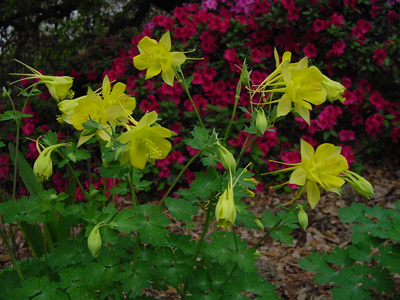
‘Texas Gold’ Columbine with Azalea background on March 24, 2007
|
Just after that I was county horticulturist in San Antonio (1987-1989 I think). When Pam found out Jerry and I were working with columbines she shared that her cousin, Emily Lot, did her graduate work at Sul Ross on them and brought one of each species and variety to Pam’s home and garden in Navasota where she planted them side by side. By the time I got to know Pam, they had hybridized (which they are prone to do) and she mailed me a slide of what she referred to as a “bastard columbine.”
When Jerry and I started trying to procure enough seed to plant seed blocks for introduction into the nursery trade, it became clear to me that folks had columbines with different looks. Some were more yellow with skinnier petals and longer spurs and some were showier, a bit bicolored with wider petals and shorter spurs. It was then that I got out my taxonomy books and studied all the columbines. It turns out that the species and varieties that existed in Texas were Aquilegia canadensis (eastern columbine), Aquilegia chrysantha chrysantha (golden columbine), Aquilegia chrysantha chaplinei (Chaplin’s columbine), Aquilegia chrysantha hinckleyana (Hinckley’s columbine), and Aquilegia longissima (long spurred columbine).
Pam’s cousin had shared the information with her. Naturally Pam shared Emily’s thesis with me.
Lott, E.J. 1979. Variation and interrelationships of Aquilegia populations of Trans-Pecos Texas. M.S. thesis, Sul Ross State University, Alpine, TX.
I’m not sure what went on while I spent two years at LSU but when I got back to San Antonio and worked as Director of R&D at Lone Star Growers, Jerry and I planted stock blocks of pure Aquilegia chrysantha hinckleyana to collect from and provide to the nursery trade for introduction. Jerry planted a nice area under a Montezuma cypress in his backyard while I planted a nice stand on a slope at Lone Star Growers. Dr. Calvin Finch, Dr. Larry Stein and Master Gardener Jean Peterson planted some of the chosen plants and collected seed yearly.
This research paper: (https://www.plantanswers.com/research_seedgermination.htm ) about growing 'Texas Gold' (Aquilegia hinckleyana) found that columbine seed should be ideally germinated under a 25 to 27C day/20C night cycle. Since this cannot be achieved in
Texas until October or November, it is recommended that current season's seed be sent to Colorado for germination and plug production. The schedule was: Nan Kelly of Lone Star Growers and my executive secretary would collect from the cooperative growers and send the current season's seed in June or July to Colorado growers; they grow plugs which are sent back to Texas in October or November; the plugs are planted directly into gallons which are finished in the field for sale in bloom in March and April. The grower who did this for years was: Welby Garden Company, 2761 East 74th Avenue, Denver, Colorado 80229 Later we ran into vernalization issues when a lack of vernalization in Colorado several years in succession virtually took the plant off the market. ColorSpot (Lone Star Nursery) threw away thousands of non-blooming columbine plants for several years.
Since there were several different kinds of golden columbines native to Texas, most of them going around as Hinckley’s, we decided to go to Big Bend to find them all! The main place I remember going was Cattail Falls in Big Bend where we photographed Aquilegia chrysantha chrysantha, NOT Hinckley’s. We also so some beautiful Aquilegia longissma in a flower bed at a local business. No Aquilegia chrysantha chaplinei (Chaplin’s columbine) or Aquilegia chrysantha hinckleyana (Hinckley’s columbine).
With the help and support of the great plantsman of West Texas, Barton Warnock (See: https://www.plantanswers.com/heroes/warnock.html) we were granted access to the ranch that owned Capote Falls, supposedly the only location where Aquilegia chrysantha hinckleyana (Hinckley’s columbine) grew. The owners were very sensitive about the location since this is the largest source of privately-owned fresh water in West Texas. The ranchers were apprehensive about showing me the plants since the Federal Government was trying to take their ranch and the water using the Endangered Species Act. However, the lady rancher was friends with Lady Bird Johnson and was intrigued with our work with the “Colorization of the Texas Bluebonnets”. Jerry had brought a slide show of the project and presented it to the ranchers. The family changed their mind and decided I could climb down beside the water fall to go see the columbines at the base of Capote Falls. After careful consideration of the possible ramifications to the rancher, Jerry and I decided not to go see the supposedly only location where Aquilegia chrysantha hinckleyana (Hinckley’s columbine) grows. Since we already had seed, we just needed to separate out Hinckley-type columbines and provide plants to the growers.
Once we had selected and named the columbine 'Texas Gold' (Aquilegia hinckleyana) growing from several different kinds of golden columbines native to Texas, it was decided by Dr. Parsons, Dr. George, and me to make it a Texas Superstar with Lone Star Growers being the main wholesale supplier.
So I went to our sales director, Tom Dickerson, and told him we needed a bunch for the promotion, but he didn’t want to grow more than a few thousand fearing we’d be stuck with them like Lone Star had been in the past with other native plant introductions. I knew that wouldn’t be enough for the state of Texas and such a pretty and special plant so I pulled rank and went to the president, Joe Bradberry, who called us both in his office to explain our points of view. I explained that we were the only source for a major promotion and what a great plant it was. Joe looked at me and said “How many should we grow?” I said at least 10,000. Joe said, “Grow 12,000,” while Tom glared at me and grimaced.
The plants grew and bloomed beautifully and sold out in one week with Tom Dickerson helping to load the trailers. The 'Texas Gold' (Aquilegia hinckleyana) would never again be considered an “Endanger Species”!
Greg Grant
Texas A&M AgriLife Extension Service
Smith County
|
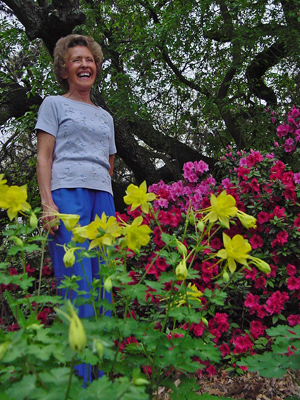
‘Texas Gold’ Columbine with Azalea background
in Mrs. Passmore's yard on March 24, 2007
|
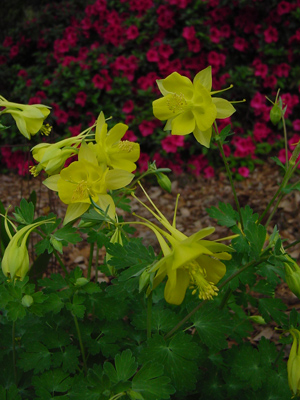
‘Texas Gold’ Columbine with Azalea background
|
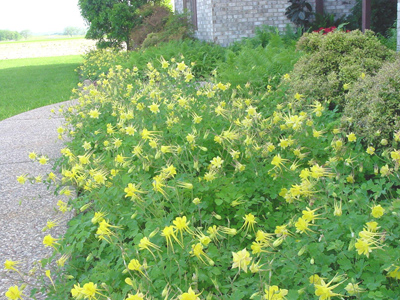
Seed increase planting of ‘Texas Gold’ Columbine
at Larry Steins in 2002
|
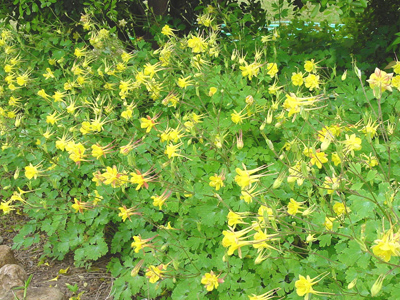
Close-up of Seed increase planting of ‘Texas Gold’ Columbine
at Larry Steins in 2002
|
|



